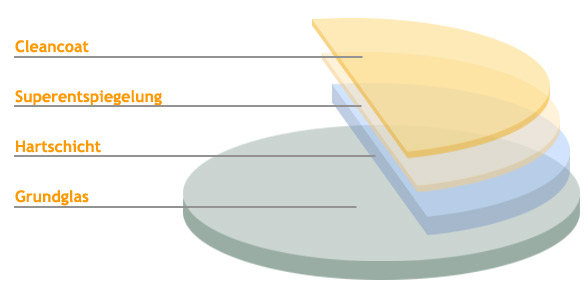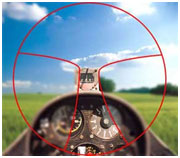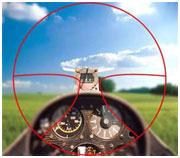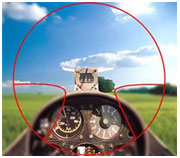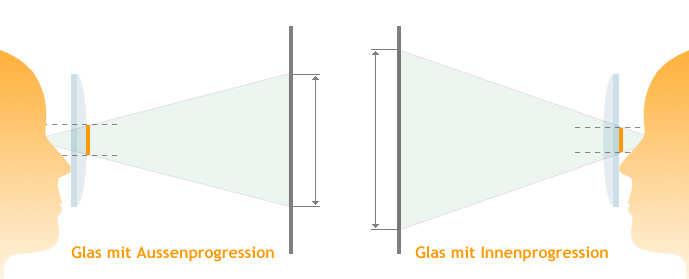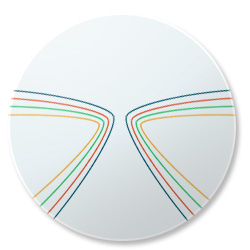Eye Advisor
Eye Advisor
|
Glasses lenses Single vision lenses are glasses lenses for which the construction only has one dioptric effect. They are mainly used for single-vision distance glasses or single-vision reading glasses. For multifocal lenses (bifocal or trifocal lenses) a special surface is applied for near vision and as necessary another for mid-distance vision. The advantage of this is that the irritating process of having to change glasses or view items over the edge of the glasses is avoided. In contrast to progressive lenses, there is also a visible divide between the two areas of vision. A progressive lens is a modern glasses lens for the correction of presbyopia. The eye lens curves markedly according to distance of the object. With presbyopia the elasticity of the lens is restricted – it hardens and thickens. The adjustment of the eye to an object that is close-to is made more difficult and the consequences are problems first and foremost with reading and working at close range. The first sign of this is the habit of holding books or magazines further away. Reading glasses for the focus range of even around 40cm can help with this. For other areas of use, multifocal or progressive lenses are more comfortable. Computer lenses: As clear vision in the middle distance is not always possible for presbyopes with single-vision reading glasses (e.g. on the computer), reading glasses are increasingly used in an increased field of vision (office lenses). Sphere
The spherical value is in dioptres and you need this in order to be able to see clearly again. As a rule, this value is given first and can be indicated with a positive (+) or negative (-) symbol. Cylinder
Provision of the cylinder value is generally not required, and is only in the case of astigmatism. As a rule, this value is given second and can be indicated with a positive (+) or negative (-) symbol. If there is a cylinder value on your prescription, a value must also be given for the axis. Axis
If you need a cylinder value, you will also always find the axis value on your prescription. This value is given in 1° steps from 0°-180°. Addition
The additional value is necessary for ordering bifocal (two-strength) or progressive (multifocal) glasses. This value is as a rule the same for both eyes and is abbreviated with NV or ADD. Pupillary distance
The distance between the centre of the pupils in both eyes to the middle of the bridge of the nose is referred to as the pupillary distance (PD). It should be noted in producing a pair of glasses so that the optical axes of the glasses lenses agree with those in the eyes. Our recommendation for the relevant dioptric values
Anti-reflective coating
It also has the secondary aesthetically pleasing effect on your appearance - your eyes are more easily discernible! Hard layer Clean Coat
Tints - fine, fashionable nuance or intensive tinting There are different tints in different tinting stages. These indicate how dark a lens is and therefore how much light reaches the eyes. Man spricht von einer When the lens has a colouration of 8-15%, it is called a light filter tint. This colouring is advisable if you are going to wear the glasses in artificial lighting conditions a lot, for example in an office, in front of the PC etc. Because in this way the lighting is registered as less uncomfortable and the eyes therefore do not tire as quickly. A 75% tint is advisable for sunglasses, and for extreme light conditions such as skiing or water-sports 85%. Lenses with a tint of more than 25% must not be worn when driving at night. Phototropic - lenses that change colour THE WAY THE DIFFERENT PROGRESSIVE LENS QUALITIES WORK
Premium Freeform internal progression
Due to their design, internal progression Freeform progressive lenses are thinner than classic external progression lenses with the same lens power and material. For internal progression lenses, the optically effective surface is on the inside of the lens, that is the side near the eye. The internal progression surface structure of the lenses means a greatly increased field of vision. In contract to classic progressive lenses, for which the optically effective area is on the outside, with these Freeform progressive lenses you achieve an up to 30 percent larger field of vision. With Freeform progressive lenses you therefore have a larger focus area than was the case with classic progressive lenses. In addition, optic image defects and the "image jumps" that are typical for progressive lenses are effectively avoided with the internal progression progressive lenses.
|
||||||||||||||||||||||||||
 DE
DE EN
EN






